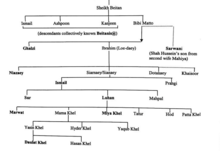Pashtun tribe in Afghanistan and Pakistan
| Lodi, Lohdi |
|---|
 The list of Lodi sub-tribes |
Lodi (Pashto; لودهی) is a Pashtun tribe from the Ghilji group of Pashtuns.[1][2]
These tribes were nomadic and migrated by crossing the Gomal Pass throughout the history.[3]
The Lodi tribe consists of many sub-tribes, most of whom are now settled in the Tank, Lakki Marwat and Dera Ismail Khan districts of Khyber Pakhtunkhwa, Pakistan.[4]
Lohani
Lohani, also known as Nuhani, is the largest sub-group among the Lodi tribe.[5] Although other Lohani tribes had also made earlier deeper incursions into India, as far as Bihar, and settled therein during the days of the Lodi dynasty.[6][7]
Earliest mentions of the Lohani
The earliest mention of the Lohani tribes comes in the form of an inscription written on a tablet from 1496 AD in Bihar during the days of the Lodi dynasty.[6] The inscription records the construction of a certain gate by Darya Khan Nuhani who is thereafter mentioned as one of the ''governors of the kingdom". The Lohani tribes were also mentioned by the Mughal Emperor Babur in his memoirs, the Baburnama, as Nuhani Afghans around 1529 AD.[7]
